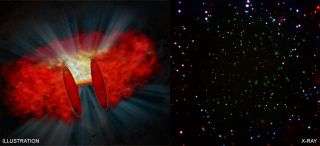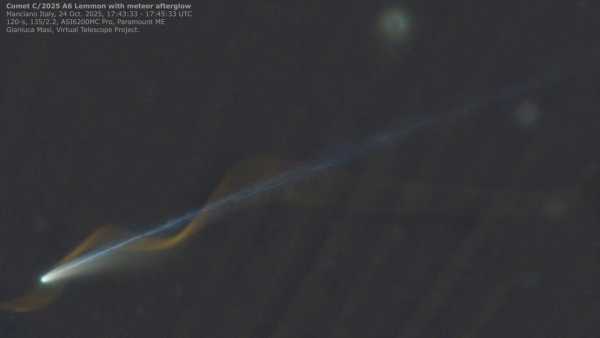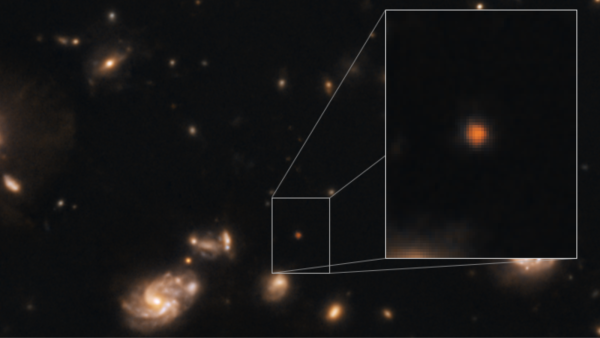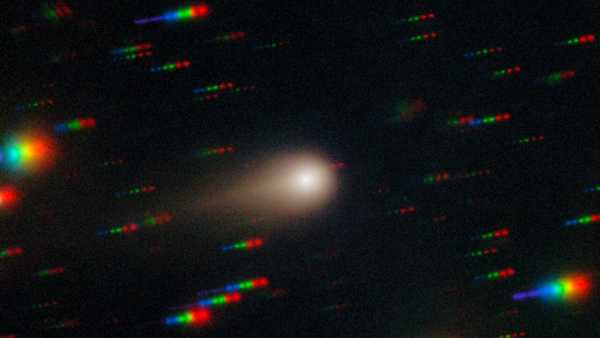
Left: An illustration shows what a shrouded black hole might look like. Right: An image of the Chandra Deep Field-South (CDF-S) highlights where the new cocooned black holes were detected.
More than two dozen missing “cocooned” black holes have been rediscovered, after researchers took a new look at X-ray maps of the sky. All of these singularities had been misclassified as distant galaxies or other types of black holes.
All 28 of the objects are supermassive black holes, billions of times the mass of our sun. And all are going through a stage of development where they shroud themselves in a dark bubble of dust and other material. Those cocoons obscure the bright X-rays emitted by hot material swirling around their event horizons, the point of no return for infalling matter, making them seem dimmer than they really are. Models of black hole formation suggest there should be lots of black holes like this across the sky, but until now, scientists hadn’t spotted as many as expected. This new research, based on observations of one patch of the southern sky, suggests many of them were hiding in plain sight.
“We like to say we found these giant black holes, but they were really there all along,” Johns Hopkins astronomer Erini Lambrides, a doctoral student who led the study, said in a statement from the Chandra X-ray Observatory.
To pick out these black holes in disguise, the researchers compared X-ray images from the Chandra Deep Field-South (CDF-S), an ultra-detailed X-ray image of a patch of southern sky, with infrared and optical observations of the same patch of sky.
Sixty-seven such shrouded supermassives had already been found in the image. But the researchers found 28 objects that looked dim in the X-ray image but bright in infrared and optical wavelengths. They turned out to be black holes at the active centers of galaxies that had been so well-hidden by their cocoons that they looked to the Chandra X-ray telescope like dimmer, older supermassive black holes or more-distant galaxies.
“Over 40% of our sample has underestimated intrinsic obscuration,” the researchers wrote in a paper published May 15 to the preprint database arXiv and soon to appear in The Astrophysical Journal, meaning that 40% of the objects they studied turned out to have been black holes with some level of cocooning that previous studies hadn’t accounted for.
Related Content
—The universe: Big Bang to now in 10 easy steps
—The 15 weirdest galaxies in our universe
—101 astronomy images that will blow your mind
That’s a big deal for two reasons, they said.
First, supermassive black hole development is complex, and astrophysicists still don’t understand it very well. The objects are so big that it’s difficult to explain how they acquired all their mass even with billions of years to gobble up matter. There just isn’t enough available mass and it takes time for any bit of mass to fall into a black hole.
This new data could improve theoretical models of how the gargantuan singularities form, revealing that black holes spend more time in that cocoon stage than previously thought. That could clarify the history of large galaxies like the Milky Way with their giant central black holes.
The second reason has to do with the “X-ray background.”
X-ray observations of the sky reveal plenty of distinct objects, but there’s also a diffuse glow outside the energy range of X-rays that Chandra — by far the most advanced X-ray telescope — can easily detect. Astronomers don’t have a clear picture of this glow. But many researchers suspect unseen black holes are involved in producing it.
A larger-than-expected population of cocooned black holes could help explain some of the least-understood portions of that X-ray background, the researchers wrote
Originally published on Live Science.
Sourse: www.livescience.com





